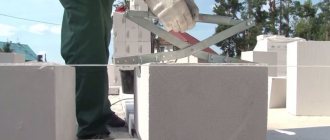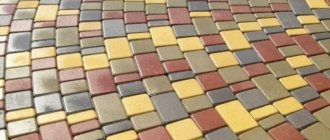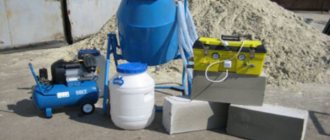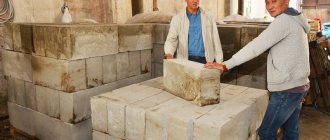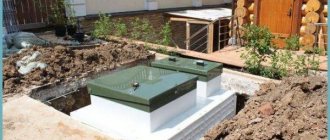Cinder block is one of the most popular building materials. It is made using the vibrocompression method from concrete mortar. A wide variety of buildings are erected from cinder blocks - from sheds and garages to bathhouses and residential buildings.
Making cinder blocks with your own hands
Are you planning to build something out of cinder blocks? Make them yourself! There is nothing complicated in the production technology of these concrete blocks. You need to thoroughly understand the operating procedure, find out the basic requirements and follow the recipe.
How to make cinder block at home?
Cinder blocks are made at home only if you plan to build a garage or other outbuilding. If you plan to build a residential building, then it is better to buy a cinder block, or use, for example, foam concrete.
For a small building, you can build a mold for making material with your own hands . For mass production, you need to acquire a special machine designed for making blocks.
It is preferable to make a mold for cinder blocks from metal
To make a block with your own hands, the first step is to draw up drawings of the form and equipment. As a rule, the mold for the material is designed so that the output is a block of standard sizes . But you can also make the block larger or smaller, depending on the type of construction and the goals pursued.
Necessary materials for work:
- wooden or metal mold for preparing the material;
- necessary components for mixing the composition;
- concrete mixer (you can make it yourself);
- a warehouse for storing cinder blocks, which prevents water from entering the material;
- vibration table (possible without it);
- vibrating machine (for making a large number of cinder blocks).
Expanded clay concrete production technology
Line for the production of expanded clay blocks
The technology for the production of expanded clay concrete blocks is almost no different from the heavy mixture technology (not taking into account that the coarse aggregate is different), it includes the same operations:
- Mixing components.
- Laying the mortar into formwork or mold.
- Consolidation of the mixture.
- Forming the block and removing the formwork.
- If necessary, steaming is used to speed up the process.
- If steaming has not been carried out, then the products or structures are maintained with special care until brand strength is achieved.
The only difference is that when making expanded clay concrete with your own hands, it is more effective to use forced mixers rather than gravity mixers. This is due to the fact that light expanded clay granules, falling from a height after being captured by the blades of a gravity concrete mixer, are mixed worse than heavy gravel or crushed stone.
How to make a block mold?
In production, the molds are made of iron or steel so that they can handle large volumes of solution, up to several tons. To produce such blocks with your own hands, you can use a wooden mold . In essence, you should get a formwork into which the cinder block mixture will be poured.
It is necessary to take into account the thickness of the wooden sheets when measuring, so that the dimensions of the future cinder block are the inside of the mold.
As a rule, to make it more convenient to remove the cinder block, the mold is made without a bottom , placing a film under the bottom. But it is necessary to ensure that the surface of the base is level, as are the wooden parts. The surface can be a flat table, a concrete surface or a sheet of iron .
To build load-bearing walls, hollow blocks are used, for which they use hollow bottles that form voids; they are pre-filled with water so that they do not float out of the solution.
What is expanded clay
Expanded clay
Expanded clay is an artificial building material. It is made by forming granules from a mixture of clay and shale, which are then fired.
- During sintering, gases are released, which form closed pores inside. Moreover, the outer layer remains almost monolithic.
- Thus, despite the presence of internal air space, expanded clay granules weakly absorb water. In addition, expanded clay is cheaper than all other porous aggregates and has good strength.
- When purchasing expanded clay, you need to take into account its brand in terms of density - the lower the density, the lower its thermal conductivity, but also its strength.
According to GOST, expanded clay is divided into fractions according to the size of the granules in millimeters:
- from 5 to 10;
- from 10 to 20;
- from 20 to 40 mm.
Expanded clay is usually sold either in bulk or packaged in containers - including in big bags, as in the photo below. To produce blocks, it is better to use the first two fractions or a mixture of them (which is even better). Although, if blocks without internal voids (solid) are planned, then a fraction of 20-40 mm can be added.
Big bags with expanded clay
Mixture composition
To learn how to make a cinder block yourself, you need to know what is included in the mixture.
The mixture for cinder blocks has the following composition:
- cement;
- water;
- sand;
- slag components.
In fact, almost any construction waste is thrown into the mixture for cinder blocks, which is not entirely correct
To make cinder blocks with your own hands, you must adhere to the following proportions:
- 7 parts slag;
- 3 parts sand;
- 1 part cement;
- 1 part water.
For the manufacture of blocks, cement grade M-400 is usually used. Of course, it is better to use M-500 cement. In this case, it can be used 10-15% less.
Possible difficulties and errors
There are several mistakes in the cinder block manufacturing process:
- materials are selected incorrectly;
- incorrect proportions;
- lack of compaction;
- poor quality drying.
Please also pay attention to the following possible non-compliance with the rules:
- If Portland cement of a grade lower than M400 is used to produce cinder blocks, the stone will be flimsy and will not be suitable for construction.
- Failure to comply with the proportions leads to an incorrect consistency of the mixture, which leads to cracks and crumbs.
- If you do not compact the mixture with a hammer or vibrating plate, there will be voids inside the stone.
- If the product is not completely dried, it will not be suitable for further use.
What can blocks be made from?
Making blocks yourself allows you to save money. Cement, of course, will have to be purchased at the store, but the remaining components can be obtained for free. Water and sand are natural elements that are not difficult to obtain. Slag components can be obtained from almost any construction waste:
- wood sawdust;
- brick break;
- broken glass;
- ash;
- crushed stone waste;
- breakage of hardened cement mortar;
- metallurgical waste.
As you can see, slag components can also be obtained for free.
Vibrating table
To do this, you need to take two long boards with a height of at least 190 mm and connect them on the sides with wooden partitions, creating a distance between the long parts of 185 mm. This can be done by using a hacksaw to form convenient grooves for all four parts of the structure. Now the side panels will be removed and put on at the time you need.
Using the same principle, we make partitions in the formwork for the future cinder block at a distance of 390 mm from each other. You should get no more than five or six cell molds for the future building material.
How to make cinder blocks yourself?
Material manufacturing process:
- The necessary components are placed in the concrete mixer in the indicated proportions. The mixture is prepared in the same way as a regular concrete mixture for building a foundation.
- The mixture is poured into a prepared form. After pouring, it must be compacted. In mass production this is done using a special vibration machine. But in its absence, this can be done by tapping the mold on top with an ordinary hammer. This is necessary so that the mixture is properly compacted and fills all the voids of the mold, and also so that all air bubbles come out. After all, the more air contained inside the block, the less its strength becomes.
- To create voids, it is necessary to place glass bottles pre-filled with water. Typically, 2 bottles are used for one block, which are placed evenly across the entire base of the mixture.
Finished cinder blocks are usually removed from the molds after 2-4 days. The material will completely harden after 28 days , only then can the blocks be used in construction. To prevent cracking of the resulting cinder blocks during hardening, they must be periodically moistened with water, especially if drying occurs in hot weather.
Voids in the block do not reduce its strength, but increase thermal insulation and noise absorption
What is expanded clay concrete
Sawed expanded clay concrete, the structure of the material is clearly visible
This is a type of lightweight concrete. It contains expanded clay, which plays the role of a coarse aggregate, like crushed stone in the heavy mixtures we are accustomed to.
The combination of expanded clay and cement provides special properties to the material:
- low specific gravity (density) , which allows you to make and lay large blocks;
- good thermal insulation properties , walls made of such blocks do not require additional insulation;
- the material is superior in water resistance to ceramics and silicate , since cement only becomes stronger in the presence of moisture;
- it is non-flammable;
- expanded clay concrete can be plastered well and finished in other ways;
- the material is in good contact with structures made of heavy concrete , which cannot be said about other types of thermal insulation.
The only disadvantages of expanded clay include lower strength and frost resistance than heavy concrete, this is due to the pores inside the filler.
Manufacturing equipment
The method described above is considered low-cost. It will be useful for those who want to build a small outbuilding. If you plan to mass produce cinder blocks, you will need special equipment, the price of which may vary according to some indicators.
The equipment for making cinder blocks is a vibrating machine . Prices per piece for it are completely different, and may differ in a number of indicators:
- manufacturer;
- power;
- performance.
| Vibrating machine | Productivity pcs | Price |
| RMU-3 | 300-450 pcs/8 hours | 21,000 rub. |
| Mars-2 | 60 pcs/1 hour | RUB 14,990 |
| Tornado | 60 pcs/1 hour | RUB 10,990 |
Books on the topic:
No comments yet
Cinder block is a building material that is produced by vibration pressing of concrete.
It is easy to build from it, the process goes quickly, and the bathhouse itself turns out to be quite warm. This is why cinder block has long gained popularity in private construction - and some even build their own profitable business on it. You just need to know the recipe, manufacturing technology and be able to automate the entire process of home production of cinder blocks.
General requirements when performing work
You can make good blocks in the garage - the main thing is to know the technology and stick to the recipe. So, a standard cinder block is 39x19x188 mm, with three small holes. And to make it high quality and durable, it is important that:
- The sand was coarse; Slag – blast furnace; Cement – high quality, no less than M400; Equipment – vibrocompressed.
The slag itself is obtained by processing coal, and, in fact, it is an ideal filler for blocks. However, recently, thanks to the active conduction of gas, much less slag and ash from coal has begun to be produced. Therefore, slag is increasingly being replaced with zito concrete, which, unfortunately, is much more expensive.
This building material is rapidly gaining popularity mainly due to the fact that it is inexpensive and has excellent heat and sound insulation.
In addition, let’s make calculations: it takes 0.011 cubic meters to make cinder blocks at home. meters of solution at a ratio of 1:7 (this is for one piece). This means that one bag of cement will yield exactly 36 blocks – which is not bad at all!
One of the most important requirements for the quality of cinder blocks is their geometry. After all, the larger the irregularities and flaws in the blocks, the more money you will have to spend on building walls.
And in order for the cinder block to turn out perfectly smooth, it is important that the vibroform itself is always filled to the brim - otherwise the blocks will turn out crooked. And not just to the brim - but with a slide, because the vibration will then slightly shake the concrete. The whole process looks like this: the vibroform is turned on once, after 5-15 seconds it is turned off, and the level of the solution in the form is assessed - if it is below the edges of the form, you need put the clamp on, turn on the vibration again - and when it hits the limiter, turn it off. This must be done at the same time: turn on the vibrator and pull out the shape.
